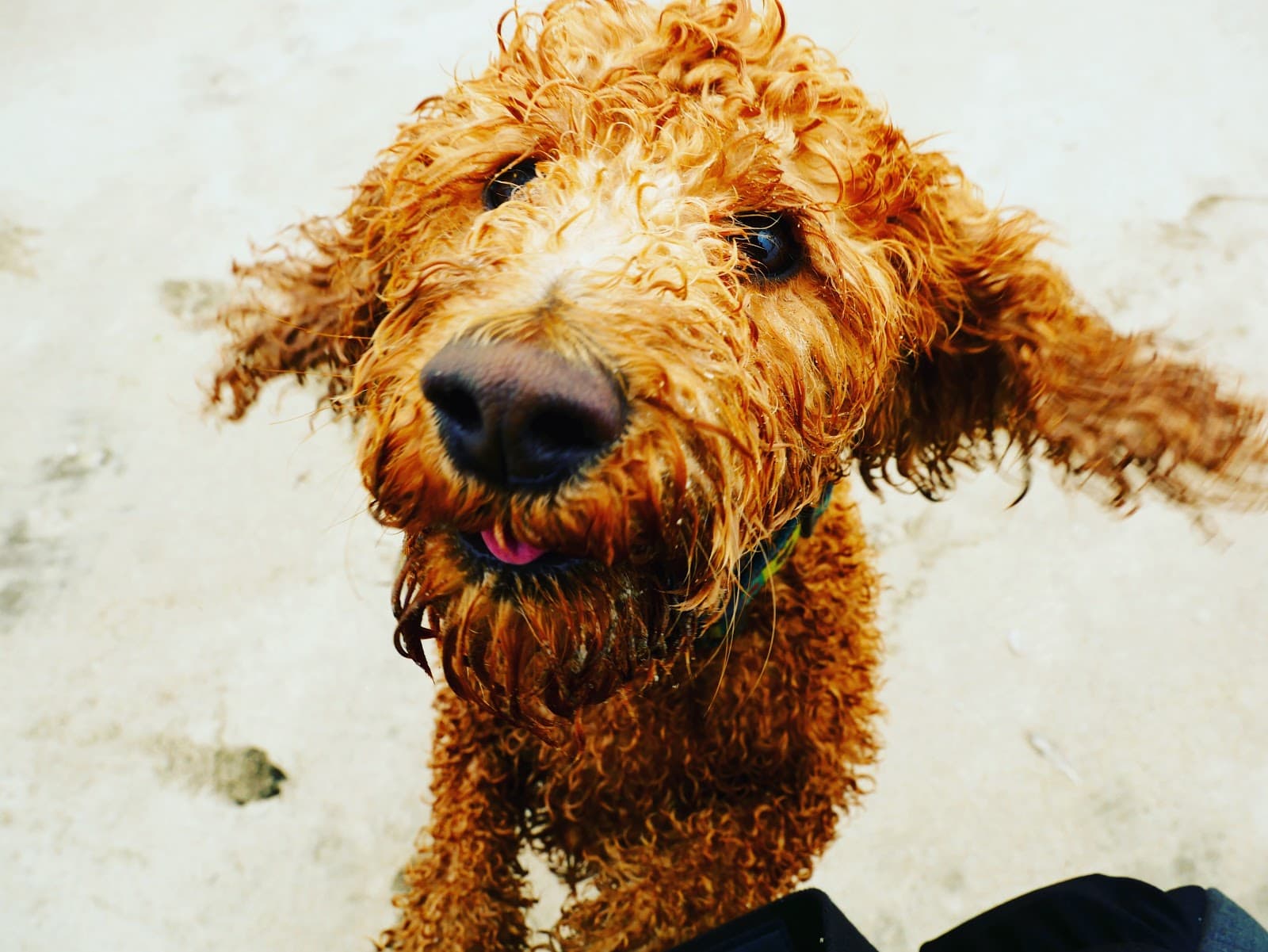Dogs of all breeds require regular grooming to maintain both healthy skin and a healthy coat. From bathing to clipping to regular coat maintenance, a dog’s needs vary depending on which coat type they possess.
Wire Coated Breeds
Dogs with wire coats have a very distinct look. A wire coat is stiff, and harsh, which gives it a wiry appearance. The most common type of dogs who possess a wire coat are terrier breeds. Airedale Terriers, Border Terriers, Scottish Terriers and Cairn Terriers. Some breeds such as Jack Russel Terriers, Daschunds, Fox Terrier, and Brussels Griffon are breeds that can come in either a smooth or wire coat.
Tips for Grooming a Wire Coated Dog
Hand Stripping is a grooming technique sometimes used for wire coats. This technique allows old hair to be removed from the follicle, so new hair can regrow in its place. Hand stripping involves firmly gripping the hair between your thumb and the side of your forefinger, and pulling in the direction of which the hair is growing. You can also purchase a number of special tools for hand stripping called stripping knives, stripping stone and a few others. The movement of the technique remains the same, with the only difference being that the hair is gripped between your thumb and the blade. When using a tool you need to be careful not to cut the hair.
Avoid Shaving to keep a wire coated dog feeling and looking naturally wiry, avoid shaving his coat. Over time, shaving a wire coated dog will cause his coat to become soft and faded in color.
Between Grooms – Even though wire coated dogs can have a shorter coat, it can mat very easily. To prevent mats, encourage owners of wire coated dogs to regularly brush and comb, paying close attention to the beard area, around where the collar is worn and in between the toes. Maintenance is extremely important; if mats are left unattended, they can cause sores and skin infections.
Grooming a wire coated dog may take some extra time and effort. However, if done regularly and correctly, that special TLC can keep the coat looking its healthiest and most beautiful!
Silky Coated Breeds
The silky coats are known for being long, shiny, and flowing. Silky Terriers, Irish Setters, Yorkies and the Maltese are all silky coated breeds. While these breeds don’t necessarily need to be bathed any more than other breeds, they require regular care and grooming for their coats to stay looking their best!
Tips for Grooming a Silky Coated Dog
Invest in a Slicker Brush – Slicker brushes come in different sizes with soft or hard bristles. The type of slicker brush you use will depend on the size of the dog and thickness of its coat. Using the wrong brush can either not get the job done correctly or can remove to much dead coat and damage the healthy growing coat. After brushing with the slicker, follow up with a comb to make sure no tangles are left.
Be Mindful of Sensitive Areas – The belly, behind the ears, inside the legs and in between the toes are not only sensitive areas, but if the coat has mats in these places, it can be painful if caught by a slicker or comb.
Between Grooms – Like any coat, regular maintenance is very important. However, silky coated breeds can mat very quickly and need to be brushed and combed almost daily to keep tangles at bay! Encourage dog owners to properly and thoroughly brush and comb between grooms.
Silky coated dogs have exceptionally beautiful coats. With the right care and proper grooming, their coats can stay looking fabulous all the time!
Double Coated Breeds
Double coated breeds have a lot of undercoat that can be shorter and more plentiful than the dog’s outercoat. This undercoat is important because it helps regulate their temperature in both warm and cool weather. Some double coated breeds include Labrador Retrievers, Pembroke Welsh Corgis, Bernese Mountain Dogs and Siberian Huskies. Double coated breeds are prone to shedding, but with proper grooming, you can keep their coat healthy and the shedding to a minimum.
Tips for Grooming a Double Coated Dog
Have the Right Tool for the Hair Type. Take special care to assess the type of hair before choosing a brush and an under coat rake to groom a double coated dog. The correct tool for the hair type is very important for a proper groom. A breed like the Corgi, would need a brush with a lot of short tines that remove it’s abundant undercoat. Followed by an undercoat rake, then a comb and maybe even a rubber curry. A Collie would need similar tools but the slicker would need longer wider tines and the rake would need to have wider teeth.
Avoid Shaving – In a double coated dog, the undercoat is essential for helping the dog to regulate his body temperature (keeping him warm, and cool). Shaving breeds with double coats can be dangerous because you remove their protection from the sun, but it can also ruin the dog’s coat. In some cases, where the undercoat is severely matted and absolutely unbrushable, or if hair needs to be removed from around a wound, shaving a double coated dog might be the only option. However, it should by no means be the first option. If the dog must be shaved, make sure he is protected from the sun in warm weather, which includes using a dog-safe sunscreen. In the colder weather, make sure he has a sweater to keep warm.
Between Grooms – Double coated dogs can easily become matted, which can be harmful to the dog’s skin if not tended to. Matted undercoat can get extremely difficult to handle, and take a lot of time to brush through. Regular brushing and deshedding can prevent mats from forming in the undercoat.
Regular grooming of double coated dogs can keep the shedding to a minimum, and ultimately keep their coat healthier and clean of dirt and debris that may get stuck in the undercoat.
Curly Coated Breeds
There are different ways to groom curly coated dogs, depending on the breed. Poodles and Bichons have a curly coat that is more hair-like, meaning their hair has a very long life cycle. This also puts them in a category of being “hypoallergenic.” These coat types can be primped, shaved and styled, such as with the pom-poms or rosettes on the Poodle or the carefully rounded head on a Bichon. Other curly coated breeds such as the Curly Coated Retriever are more fur-like, making slight trimming on the legs and tail sufficient if you are trying to keep them looking crisp and neat.
Tips for Grooming a Curly Coated Dog
Avoid Over Conditioning – Never use a heavy conditioner on curly coated breeds before trimming. Doing so can cause the hair to fall flat and lose its texture. For example, a well bred Poodle with a proper coat will have hair that stands up, and makes it easier to create those top-knots and pom-poms. Using the wrong conditioner will cause the texture to become softer and begin to droop.
Drying and Texture – Depending on the aesthetic you’re going for, how the coat is dried can make all the difference. To get the best finish on a fluffy coat, using a professional velocity dryer will produce the right effect. Letting the coat air-dry will cause the curls to look more defined. Unless the dog is being groomed for show, it’s truly the owners preference.
Between Grooms – Caring for a curly coated breed can be easy or tedious, depending on the type of coat and length. Breeds with more hair-like coats can become tangled and matted easily. Weekly to even daily brushing with a slicker and a comb can keep the coat healthy and tangle free. However coats that are more fur-like, don’t need to be brushed as frequently.
Curly coated dogs have definitely gotten a silly reputation of being the “prissy, girly-girl” dogs. However, there are so many different breeds that are considered to be in the curly coat category. Even Poodles, who are stereotyped into this “prim and proper” misconception have at least 10 different types of haircuts, in different styles. Many of these are short and practical for everyday wear and minimal maintenance!
Hairless Breeds
It is a common misconception that hairless dogs do not require any grooming, but hairless breeds such as the Chinese Crested, Argentine Pila, Peruvian Inca Orchid and the Xoloitzcuintli (Mexican Hairless Dog) often times require more care than breeds with double coats and curly coats do. Grooming a hairless breed does not require any kind of special brush, but caring for their skin is what’s important.
Tips for Grooming a Hairless Dog
Proper Bathing and moisturizing – A mild shampoo that is going to keep the dog’s skin pH levels balanced is the best choice. Because bathing will also need to be more frequent with a hairless breed, their skin may dry out more quickly, making moisturizer a necessity. Look for a moisturizer that is labeled as comedogenic, meaning that it will not clog pores.
Pay Attention to Skin Conditions – When grooming a hairless breed, pay attention to possible skin abrasions and blemishes. Make owners aware of any skin issues you might see as a potential problem.
Between Grooms – A hairless breed’s skin is constantly exposed to the elements and other irritants on a daily basis without any natural protection. These breeds are more prone to sunburn and will need a dog-friendly sunscreen applied daily.
From no coated to double coated, every coat type requires different maintenance. Make sure to use the proper tools and techniques for the breed and hair being groomed. Keeping the dog’s coat clean and healthy will make for a content canine, indeed!
Abi Pennavaria
Abi Pennavaria is a dog mom, avid volunteer veterinarian, and co-author of Saved By The Bark blog. She enjoys sharing tips and tricks for dog owners of all breeds.

